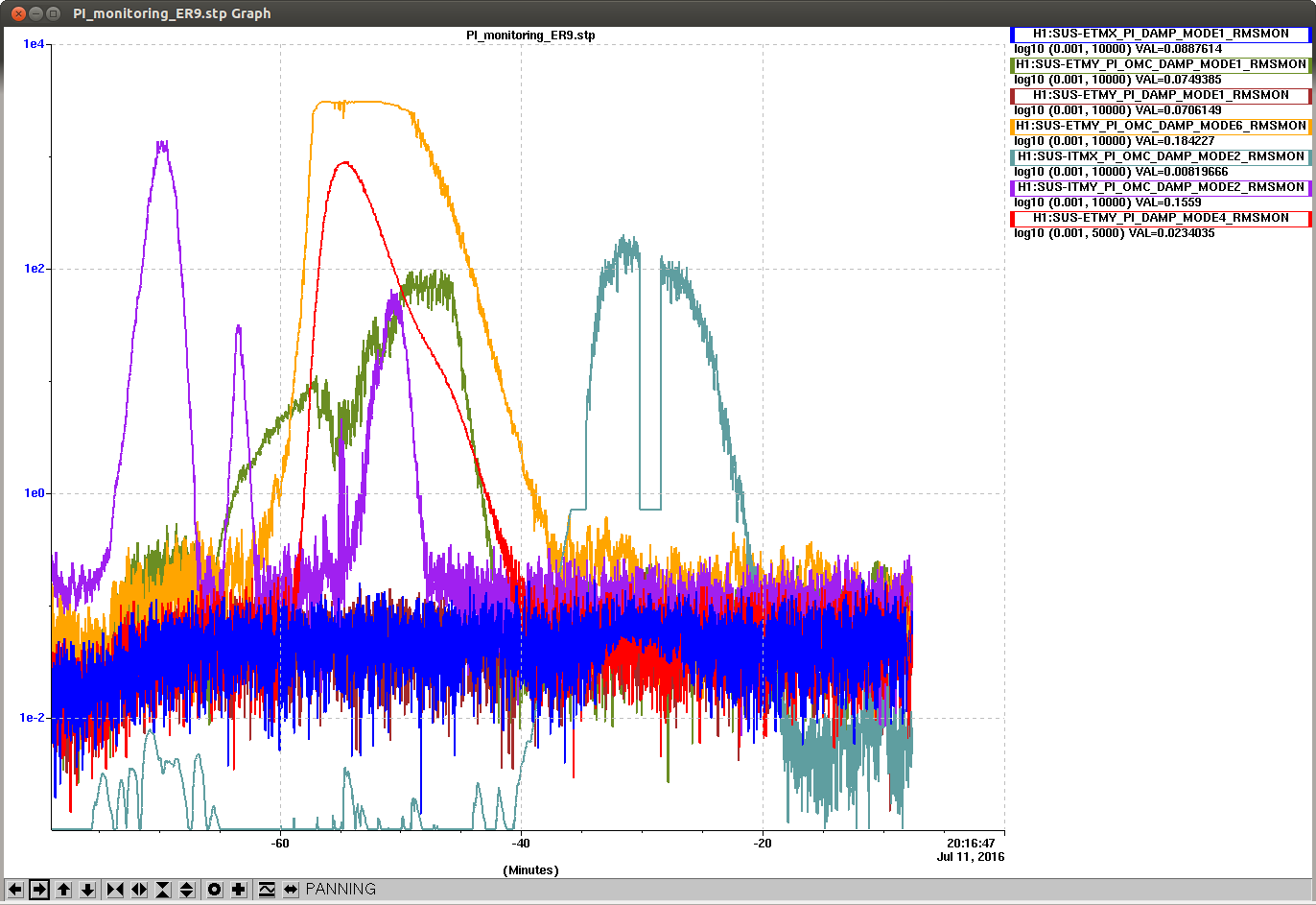[Jenne, Robert]
As a result of Keita's alog 28196 regarding the beam position on the BS, we wanted to move the beam splitter around in relation to the beamline, to see if that would change any clipping that we may have on the baffles. Short answer: nope.
First, we moved ST1 by putting offsets in the isolation loops. JeffK tells us that these are calibrated in nm, so our 5,000 count offsets correspond to about 0.5mm of motion. We moved ST1 up and down, as well as laterally along the plane of the beam splitter (+x+y and -x-y). No effect seen in the power recycling gain.
Next, we moved HEPI in a similar fashion. The thought here is that the ITM elliptical baffles are suspended from this ST0, so we weren't moving them earlier. (By moving both ST1 and ST0 we had hoped to differentiate which set of baffles was causing us trouble.) We moved up and down, as well as in RZ, rotation about the z-axis. RZ is calibrated into nrad, and the baffles are order 1m away from the center of the ISI, so they were each moved on the order of 0.5mm also. Again no effect seen in power recycling gain.
Attached is a snapshot of our striptool, with the first offsets starting at about 0:06:00 UTC, and the last ones ending around 1:00:00 UTC. Teal is the power recycling gain. The POP18 seems to be still relaxing from the power up to 40W for the first few minutes of our tests, but doesn't seem to be correlated with our movements. Red trace is the vertical CPS measure of BS ST1 ISI position, and orange is superimposed with brick red measuring our lateral motion. Light purple is vertical HEPI motion and light green is RZ HEPI motion.
We felt that if we were really dominated by clipping losses around the beam splitter, moving by 0.5mm in some direction should show us some change in recycling gain. Since it doesn't, we conclude that the power loss must be somewhere else.







 The purple line here refers to the 14980Hz ITMY mode which needed to change phase 3 times in order to damp it. At the start of the lock it was set at -60 degrees. After the first increase it was changed to 0 degrees and it went down. After 5 minutes it started ringing up again and so I changed the phase to 60 degrees. This damped it for ~13 minutes and then rang up again so I changed the phase to 30 degrees which damped it again.
The yellow line and the red line refer to the QPD and OMC rms for the 18040Hz ETMY mode respectively. After seeing the difference between the rms of the OMC and QPD signal earlier it becomes more apparent that at larger mode amplitude the QPD signal becomes more reliable. After this mode became unstable I changed the phase to -30 degrees which damped the mode. This mode is currently being damped using the QPD signal.
The dark green is the 15009Hz mode which rings up a bit more slowly than the rest. I changed the phase from 0 degrees to 60 degrees which damped it.
The light blue line is the 15520Hz ITMX mode. I had iwave tracking on this one but I had to change to just a bandpass filter after the rms started clipping. I changed the phase from -30 degrees to 30 degrees which damped the mode.
The purple line here refers to the 14980Hz ITMY mode which needed to change phase 3 times in order to damp it. At the start of the lock it was set at -60 degrees. After the first increase it was changed to 0 degrees and it went down. After 5 minutes it started ringing up again and so I changed the phase to 60 degrees. This damped it for ~13 minutes and then rang up again so I changed the phase to 30 degrees which damped it again.
The yellow line and the red line refer to the QPD and OMC rms for the 18040Hz ETMY mode respectively. After seeing the difference between the rms of the OMC and QPD signal earlier it becomes more apparent that at larger mode amplitude the QPD signal becomes more reliable. After this mode became unstable I changed the phase to -30 degrees which damped the mode. This mode is currently being damped using the QPD signal.
The dark green is the 15009Hz mode which rings up a bit more slowly than the rest. I changed the phase from 0 degrees to 60 degrees which damped it.
The light blue line is the 15520Hz ITMX mode. I had iwave tracking on this one but I had to change to just a bandpass filter after the rms started clipping. I changed the phase from -30 degrees to 30 degrees which damped the mode.














